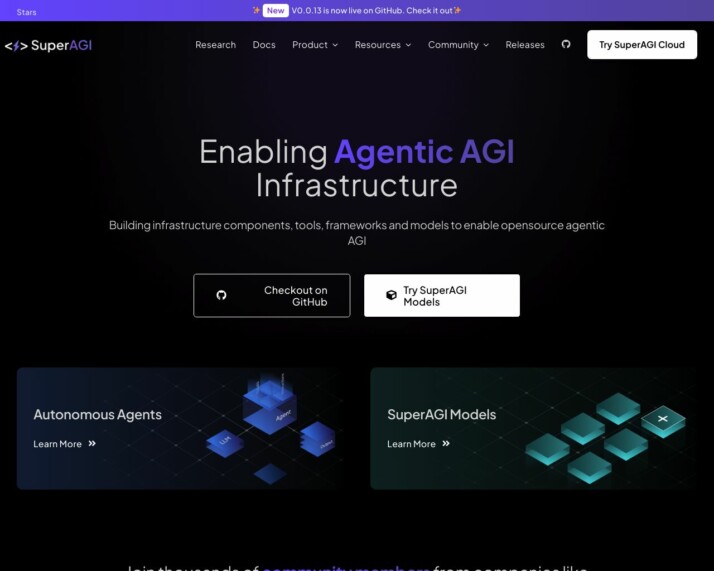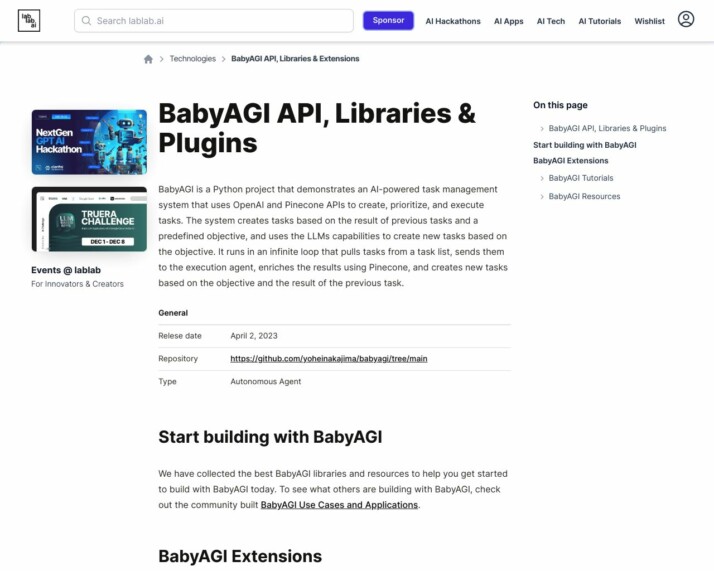Introduction
Deciding on the right artificial intelligence platform in today’s competitive tech landscape can be overwhelming. With so many options available, it’s crucial to choose a platform that aligns with your specific needs and goals. In this article, we’ll simplify this task by providing an in-depth comparison between two leading contenders: SuperAGI vs BabyAGI.
SuperAGI and BabyAGI are both frontrunners in the industry, each offering unique features and capabilities. SuperAGI focuses on bringing the power of AI to a broad user base with its easy-to-integrate solutions. On the other hand, BabyAGI aims to revolutionize the field with its user-centric AI tools that enable complex problem-solving and information retrieval.
Join us as we dissect the offerings, features, target audience, and more, of these two platforms. Whether you’re a tech-savvy enterprise, a product developer, or simply interested in leveraging advanced AI solutions, this comparison will help you make an informed decision.
Overview of SuperAGI – Unleashing the Power of Artificial General Intelligence


SuperAGI is a future-focused company that is pushing the boundaries of artificial intelligence. Its offerings revolve around constructing independent, scalable AI agents capable of tackling a wide array of tasks, learning from their interactions, and operating autonomously.
- Support for Foundational AI Models: SuperAGI incorporates top AI models like GPT-3.5 and GPT-4, highlighting a strong commitment to leveraging the most cutting-edge AI technologies.
- Autonomous Agent Creation and Deployment: The core focus of SuperAGI is developing self-reliant agents that can reason, execute tasks, make decisions, and learn from previous interactions without constant human input.
- Scalability and Flexibility: The SuperAGI platform is crafted to be scalable, meaning that it can handle increased demands and intricate AI operations efficiently.
- Scheduled Agent Deployment: SuperAGI provides the possibility to schedule AI agents, automating operations at set times or periods, enhancing AI’s efficiency and use in various sectors.
- Comprehensive File Format Support: SuperAGI’s platform supports multiple file formats including PDF, Word documents, and plain text files.
- Graphical User Interface: The platform integrates a user-friendly interface, simplifying interaction and control of AI agents moreover for users lacking deep technical know-how.
SuperAGI’s vision revolves around democratizing access to powerful AI technologies, thereby enabling a wider range of users and businesses to utilize autonomous AI agents for diverse applications. Their dedication to creating scalable, user-friendly, and adaptable AI tools underpins this vision.
The target audience for SuperAGI ranges from businesses envisioning to integrate AI into their operations, developers and AI researchers keen on advancing AI models, innovation teams and startups seeking to innovate with AI-driven solutions, to those in search of AI competency for automation and operational efficiency.
In essence, SuperAGI stands at the vanguard of crafting self-reliant AI systems, making its offerings highly relevant to the present-day technology market.
Exploring BabyAGI: Revolutionizing Artificial General Intelligence


BabyAGI is an innovative system in the realm of artificial general intelligence (AGI) designed to automate tasks and manage them efficiently. This autonomous tool is not restricted to basic functionalities like reading word documents or processing plaintext files. Instead, it harnesses the power of advanced technologies such as GPT-4 and Pinecone’s vector search engine to conduct complex problem-solving and data analysis.
BabyAGI is particularly appealing for:
- Business Professionals and Organizations: Its autonomous task generation and execution abilities can increase productivity in various business operations.
- Developers and Tech Enthusiasts: The platform’s advanced integration of cutting-edge AI technologies offers practical value.
- Individuals Seeking Personal Assistants: BabyAGI can manage and automate daily tasks, assisting with personal time and task management.
- Industries with Complex Information Needs: Industries that require extensive information retrieval and analysis, like finance, research, legal, and healthcare, could find BabyAGI particularly useful.
BabyAGI does not support several features such as a visual builder, debug mode, or multi-agent collaboration. Instead, it focuses on offering autonomous function powered by foundational AI models such as OpenAI’s GPT series. This approach allows BabyAGI to remember past interactions and use this context in ongoing processes.
In summary, BabyAGI strives to cater to a broad audience, ranging from business professionals seeking efficiency to individuals and industries with complex information processing needs. By understanding BabyAGI’s features and vision, it’s easier to gauge its unique market position and how its innovative approach is revolutionizing artificial general intelligence.
SuperAGI vs BabyAGI vs SmythOS: A Feature Comparison Unveiling the Power of Large Language Models
Let’s dive into the feature comparison of SuperAGI, BabyAGI, and SmythOS. Taking a closer look at their integration capabilities, useability, performance, and scalability can help you decide which platform suits your needs the best.
| Features | SuperAGI | BabyAGI | SmythOS |
|---|---|---|---|
| Hosted Agents (Dev, Production) | ❌ | ❌ | ✅ |
| Environments (Dev, Production) | ❌ | ❌ | ✅ |
| Visual Builder | ✅ | ❌ | ✅ |
| No-Code Editor | ❌ | ❌ | ✅ |
| Memory & Context | ✅ | ✅ | ✅ |
| Autonomous Agents | ✅ | ✅ | ✅ |
| Explainability and Transparency | ❌ | ❌ | ✅ |
| Debug Mode | ❌ | ❌ | ✅ |
| Multimodal | ❌ | ❌ | ✅ |
| Problem-Solving Capabilities | ✅ | ✅ | ✅ |
Looking at the differences, it is evident that SuperAGI and BabyAGI both lack in various areas compared to SmythOS. The absence of features like Hosted Agents and Environments in both SuperAGI and BabyAGI drastically diminishes their integration capabilities, rendering them less flexible for various applications. Moreover, the lack of a Visual Builder and No-Code Editor in BabyAGI significantly reduces ease of use.
When comparing the SuperAGI and BabyAGI features to SmythOS, SmythOS is clearly supreme. Its comprehensive feature set ensures higher performance and scalability for demanding applications. It also steps ahead with its unmatched Explainability and Transparency, Debug Mode, and Multimodal features, enhancing the overall user experience and paving the way for efficient problem-solving.
SuperAGI vs BabyAGI: Identifying the Target Audience
In this section, we will explore the target audience for SuperAGI and BabyAGI, focusing on their end-users, target markets, and applications. Understanding the intended audience will help readers determine which company’s offerings align better with their specific requirements.
The Target Audience for SuperAGI
- Businesses and Enterprises: SuperAGI’s platform is designed to cater to businesses of all sizes that are looking to integrate AI into their operations. With its ability to process various data types, including text and document formats, SuperAGI is suitable for enterprises dealing with large volumes of data and seeking efficient data processing and analysis capabilities.
- Developers and AI Practitioners: SuperAGI offers support for foundational AI models like GPT-3.5 and GPT-4, along with hosted vector databases, making it an attractive tool for developers and AI researchers. The platform’s graphical user interface also indicates accessibility for users with varying levels of coding expertise, including those who prefer a more visual approach to AI development.
- Innovation Teams and Startups: SuperAGI provides tools for startups and innovation teams to create and test new AI-driven products and services. Its scalability and flexibility make it a suitable choice for smaller, agile teams that need to quickly adapt and evolve their AI capabilities.
- Technology Integrators and Consultants: SuperAGI’s versatility and ability to handle different types of data inputs make it a powerful tool for technology integrators and consultants specializing in AI integration and implementation. It enables them to provide custom AI solutions tailored to their clients’ specific needs.
- Automation and Efficiency Seekers: Companies looking to automate processes and increase operational efficiency can benefit from SuperAGI’s autonomous agents and scheduled deployment feature, which allows for automated operations and streamlined workflows.
The Target Audience for BabyAGI
- Business Professionals and Organizations: BabyAGI is well-suited for business environments where there is a need for efficient task management and automation. It can aid in handling routine tasks, data analysis, and complex problem-solving, potentially increasing productivity in various business operations.
- Developers and Tech Enthusiasts: BabyAGI’s integration of cutting-edge AI technologies makes it appealing to developers and tech enthusiasts interested in practical applications of advanced AI technologies like GPT-4 and Pinecone’s vector search engine.
- Individuals Seeking Personal Assistants: BabyAGI can be a valuable tool for individuals looking for an AI-driven personal assistant to manage and automate daily tasks. Its ability to understand complex tasks and autonomously execute them can aid in personal time and task management.
- Industries with Complex Information Needs: BabyAGI is particularly useful for industries requiring complex information retrieval and analysis, such as research, legal, finance, or healthcare. Its AI capabilities can assist in sifting through large volumes of data to find relevant information.
In summary, SuperAGI’s products and features cater to a diverse audience, including businesses seeking AI integration, developers and AI practitioners, startups and innovation teams, technology integrators and consultants, and companies looking for automation and efficiency.
On the other hand, BabyAGI caters to a broad audience, ranging from business professionals seeking efficiency in task management to individuals and industries with complex information processing needs. Its unique combination of AI technologies positions it as a versatile tool for various applications in both professional and personal contexts.
Conclusion
After carefully examining the advantages and disadvantages of both AI systems, SuperAGI and Baby AGI, it is clear that SmythOS is the favored choice in terms of scalability, flexibility, and comprehensive file format support. SuperAGI offers scalability and the ability to handle complex AI operations efficiently, making it suitable for businesses looking to expand their AI capabilities.
However, SuperAGI does not explicitly qualify as offering hosted agents or distinct development and production environments, which may limit its applicability for some users.
In contrast, Baby AGI stands out for its autonomous task generation and execution capabilities. It leverages advanced AI technologies like GPT-4 and Pinecone’s vector search engine, enabling it to understand complex tasks and find relevant information efficiently. However, it lacks specific features for explainability, transparency, and multimodal support.
Considering the intended audiences, SuperAGI caters to tech-savvy enterprises, product developers, and IT professionals seeking to leverage AI for various applications. On the other hand, Baby AGI appeals to business professionals, developers, and individuals seeking personal assistants. It also finds relevance in industries with complex information needs, such as research, legal, finance, or healthcare.
In conclusion, while both SuperAGI and Baby AGI have their advantages, SmythOS emerges as the superior choice. Its scalable and versatile AI tools, compatibility with multiple file formats, and commitment to user-friendly features make it the ideal platform for a wide range of users and businesses. With SmythOS, users can leverage the power of autonomous AI agents to automate tasks, solve complex problems, and enhance productivity.
Last updated:
Disclaimer: The information presented in this article is for general informational purposes only and is provided as is. While we strive to keep the content up-to-date and accurate, we make no representations or warranties of any kind, express or implied, about the completeness, accuracy, reliability, suitability, or availability of the information contained in this article.
Any reliance you place on such information is strictly at your own risk. We reserve the right to make additions, deletions, or modifications to the contents of this article at any time without prior notice.
In no event will we be liable for any loss or damage including without limitation, indirect or consequential loss or damage, or any loss or damage whatsoever arising from loss of data, profits, or any other loss not specified herein arising out of, or in connection with, the use of this article.
Despite our best efforts, this article may contain oversights, errors, or omissions. If you notice any inaccuracies or have concerns about the content, please report them through our content feedback form. Your input helps us maintain the quality and reliability of our information.
Alexander De Ridder
Co-Founder, Visionary, and CTO at SmythOS. Alexander crafts AI tools and solutions for enterprises and the web. He is a smart creative, a builder of amazing things. He loves to study “how” and “why” humans and AI make decisions.
Explore All Comparison Articles
Decisions vs. Sola: AI Workflow Automation Showdown
AI-powered workflow automation platforms revolutionize how businesses streamline operations and boost productivity. This comparison explores Decisions vs. Sola, and SmythOS,…
DeepOpinion vs. Sola: Comparing AI Automation Platforms
AI-powered automation platforms revolutionize business operations, but choosing the right solution can be challenging. This comparison of DeepOpinion vs. Sola,…
DevGPT vs. Sola: AI-Powered Development Tools Compared
AI-powered development tools revolutionize software creation, offering unprecedented efficiency and capabilities. This comprehensive review compares DevGPT vs. Sola, and SmythOS,…
Fine AI vs. Sola: Comparing AI Automation Tools
AI-powered automation transforms software development and business workflows, offering unprecedented efficiency and innovation. Fine AI vs. Sola present distinct approaches…
FlowiseAI vs. Sola: Comparing AI Automation Platforms
AI-powered automation revolutionizes business operations, driving efficiency and innovation across industries. FlowiseAI vs. Sola offer distinct approaches to harness this…
Gooey AI vs. Sola: AI-Powered Automation Platforms Compared
AI-powered automation platforms revolutionize how businesses streamline operations and enhance productivity. This comparison delves into Gooey AI vs. Sola, two…

